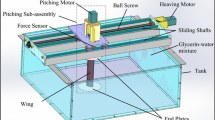Abstract
Numerical simulations are conducted to investigate the mechanism of hovering flight with an inclined stroke. The Reynolds numbers considered are 150 and 1000 based on the maximum translational velocity and wing chord length. Three mechanisms responsible for high vertical force generation, suggested by Dickinson et al. (1999), are confirmed and more elaborated in the present study. First, we show that the vertical force during downstroke is larger than that from the quasi-steady analysis due to the delayed stall mechanism. Second, the wing-wake interaction of reducing the negative vertical force during the stroke reversal is explained in terms of the reattachment of the vortex, shed previously during downstroke, on the wing, by which the wing is submerged in a low pressure region during upstroke and has a smaller negative vertical force. Finally, the rotational circulation is explained by advancing the rotation timing of the wing at supination using both the numerical simulation and inviscid potential theory.
Similar content being viewed by others
Abbreviations
- a :
-
Major axis of the ellipse
- A m :
-
Stroke amplitude
- b :
-
Minor axis of the ellipse
- c :
-
Chord length of the wing
- C D :
-
Drag coefficient
- C H :
-
Horizontal force coefficient
- C L :
-
Lift coefficient
- C rot :
-
Hydrodynamic lift force coefficient due to wing rotation
- C V :
-
Vertical force coefficient
- C Va :
-
Vertical force coefficient due to added mass
- C Vqs :
-
Vertical force coefficient with the quasisteady assumption
- f :
-
Wing beat frequency
- g :
-
Gravity acceleration
- h :
-
Thickness of the wing
- l :
-
Wing span
- p :
-
Pressure
- Re :
-
Reynolds number,Re =u max c/v
- t :
-
Time
- T :
-
Period of the flapping motion
- u d ,u d :
-
Translational velocity of the wing
- umax :
-
Maximum translational velocity during flapping
- x′:
-
Position vector in a moving reference frame, (x′,y′)
- (x c ,y c ):
-
Position of the wing center
- α:
-
Angle between the chord axis and the stroke plane
- α d :
-
Constant value of α during the down-stroke period
- ga d :
-
Optimal αd for maximum vertical force
- αu :
-
Constant value of α during the upstroke period
- β:
-
Angle of the stroke plane to the horizontal axis
- v :
-
Kinematic viscosity
- ρ:
-
Fluid density
- Ω, ω:
-
Angular velocity of the wing
References
Beddhu, M., Taylor, L. K. and Whitfield, D., 1996, “Strong Conservative Form of the Incompressible Navier-Stokes Equations in a Rotating Frame with a Solution Procedure,”J. Comput. Phys., Vol. 128, pp. 427–437.
Bennett, L., 1970, “Insect Flight: Lift and Rate Change of Incidence,”Science, Vol. 167, pp. 177–179.
Birch, J. M. and Dickinson, M. H., 2001, “Spanwise Flow and the Attachment of the Leading-Edge Vortex on Insect Wings,”Nature, Vol. 412, pp. 729–733.
Dickinson, M. H., Lehmann, F. O. and Sane, S. P., 1999, “Wing Rotation and the Aerodynamic Basis of Insect Flight,”Science, Vol. 284, pp. 1954–1961.
Ellington, C. P., 1984a, “The Aerodynamics of Hovering Insect Flight. I. The Quasi-Steady Analysis,”Phil. Trans. R. Soc. Lond. B, Vol. 305, pp. 1–15.
Ellington, C. P., 1984b, “The Aerodynamics of Hovering Insect Flight. III. Kinematics,”Phil. Trans. R. Soc. Lond. B, Vol. 305, pp. 41–78.
Ellington, C. P., 1984c, “The Aerodynamics of Hovering Insect Flight. IV. Aerodynamic Mechanisms,”Phil. Trans. R. Soc. Lond. B, Vol. 305, pp. 79–113.
Ellington, C. P., Berg, C. van den, Willmott, A. P. and Thomas, A. L. R., 1996, “Leading-Edge Vortices in Insect Flight,”Nature, Vol. 384, pp. 626–630.
Francis, R. H. and Cohen, J., 1933, “The Flow Near a Wing Which Starts Suddenly from Rest and Then Stalls,”Rep. Memo. Aeronaut. Res. Comm., Vol. 1561.
Kim, D. and Choi, H., 2006, “Immersed Boundary Method for Flow Around an Arbitrarily Moving Body,”J. Comput. Phys., Vol. 212, pp. 662–680.
Kim, J., Kim, D. and Choi, H., 2001, “An Immersed-Boundary Finite-Volume Method for Simulations of Flow in Complex Geometries,”J. Comput. Phys., Vol. 171, pp. 131–150.
Liu, H., Ellington, C. P., Kawachi, K., Berg, C. and Willmott, A. P., 1998, “A Computational Fluid Dynamic Study of Hawkmoth Hovering,”J. Exp. Biol., Vol. 201, pp. 461–477.
Newman, J. N., 1986,Marine Hydrodynamics., The MIT Press.
Norberg, R. A., 1975, “Hovering Flight of the Dragonfly Aeschnia Juncea L., Kinematics and Aerodynamics,”In Swimming and Flying in Nature., Prenum Press, Vol. 2, pp. 763–781.
Pauley, L. P., Moin, P. and Reynolds, W. C., 1990, “The Structure of Two-Dimensional Separation,”J. Fluid Mech., Vol. 220, pp. 397–411.
Sun, M. and Tang, J., 2002, “Unsteady Aerodynamic Force Generation by a Model Fruit Fly Wing in Flapping Motion,”J. Exp. Biol., Vol. 205, pp. 55–70.
Vogel, S., 1994,Life in Moving Fluids., Princeton University.
Wakeling, J. M. and Ellington, C. P., 1997, “Dragonfly Flight II. Velocities, Accelerations and Kinematics of Flapping Flight,”J. Exp. Bio., Vol. 200, pp. 557–582.
Walker, P. B., 1931, “Experiments on the Growth of Circulation About a Wing and an Apparatus for Measuring Fluid Motion,”Rep. Memo. Aeronaut. Res., No. 1402.
Wang, Z. J., 2000, “Two Dimensional Mechanism for Insect Hovering,”Phys. Rev. Lett., Vol. 85, pp. 2216–2219.
Wang, Z. J., Birch, J. M. and Dickinson, M. H., 2004, “Unsteady Forces and Flows in Low Reynolds Number Hovering Flight: Two-Dimensional Computations vs Robotic Wing Experiments,”J. Exp. Biol., Vol. 207, pp. 449–460.
Weis-Fogh, T. and Jenson, M., 1956, “Biology and Physics of Locust Flight,”Philos. T. Roy. Soc. London B, Vol. 239, pp. 415–584.
Author information
Authors and Affiliations
Corresponding author
Rights and permissions
About this article
Cite this article
Kim, D., Choi, H. Two-dimensional mechanism of hovering flight by single flapping wing. J Mech Sci Technol 21, 207–221 (2007). https://doi.org/10.1007/BF03161726
Received:
Revised:
Issue Date:
DOI: https://doi.org/10.1007/BF03161726




